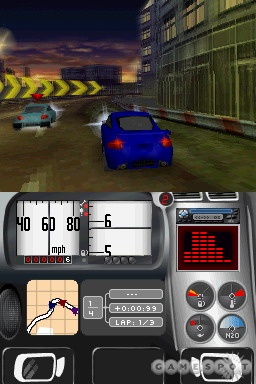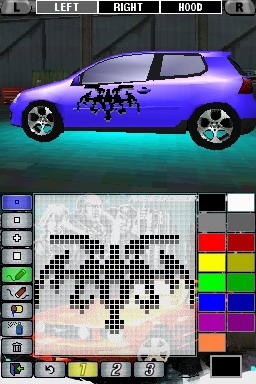Aficionados of scrappy, arcade-style racing games will feel right at home with Need for Speed Carbon for the Nintendo DS. While the DS game doesn't include all of the features that its counterparts on the PlayStation 2 and Xbox have, it does ape enough of their features and atmosphere such that it delivers the same sort of spirited street-racing experience. Beyond that, it's also a fun, sometimes-hectic game that gives players a good selection of cars, parts, and courses to fiddle with.

Generally speaking, Carbon is set up like you'd expect it to be. You compete against opponents in various circuit, elimination, sprint, and endurance-type races; new courses and cars unlock along the way; and your victories net you points that you can use to buy new cars and upgrade your old ones. Each of the game's 12 courses emphasizes a different setting and structure, and you'll find shortcuts all over the place. The driving is fast-paced, and the cars feel sufficiently heavy. The artificial intelligence, meanwhile, does a good job of nudging fenders without coming across as unfair. Smashing into oncoming traffic can lead to a spectacular crash, but the AI usually isn't so harsh that one or two collisions will knock you out of contention. At least CPU opponents are subject to the same mishaps, unlike in last year's game when they would simply pass right through commuter traffic. As for the controls, everything you'd want at your fingertips is there. Steering is mapped to the directional pad; the shoulder buttons handle braking and acceleration; and the main buttons activate the handbrake, wingman, and nitro functions.
Three exciting new gamebreaker features help distinguish Carbon from previous Need for Speed games. Two of these are rewind and slow-motion abilities, which let you recover from crashes and slow down the action just by pressing a button. The other, more significant new addition is the wingman. In a nutshell, you have a buddy in the race that will come to your aid with a helpful block or draft whenever you summon them. Blockers will try to nudge and T-bone the other CPU cars. Drafters, on the other hand, will get in front of you and cut down on your car's wind resistance, helping you achieve a higher top speed. They also refill your nitrous, rewind, and slow-mo tanks while you draft behind them. Wingmen are a welcome addition to the Need for Speed formula, as they can instigate some awesome crashes and change the pecking order in an instant. About the only downside to them is that you can't have both a blocker and a drafter in a single race. You must pick one or the other before the race starts. As such, you have to decide which strategy is more important, slowing down the other competitors or being able to refill your nitro, rewind, and slo-mo tanks.
Of course, Carbon is still very thick with the unique features that people have come to associate with the Need for Speed franchise. You're not just racing to win a title. Instead, with every win, you're taking away turf from six rival gangs and bringing their members into your posse as wingmen. Some animated comic-book-style cutaways gradually reveal the ins and outs of the story as you capture more turf and enlist new allies. In true Need for Speed fashion, the game lets you amass a stable of as many as 15 real-world cars and provides a ridiculous selection of performance and visual kits to upgrade them with. We're talking dozens upon dozens of engine, transmission, and body upgrades, as well as spoilers, hoods, paint jobs, and vinyl decals. And then there are the crashes and nitro boosts. Bumping and plowing into opponents is OK. Or, if you need to blow past them, you've got a nitrous button that you can push to kick the car into overdrive.
For the most part, the graphics and audio convey all of the excitement with gusto, although the limitations of the hardware are obvious. The 3D environments are busy with tunnels, overpasses, buildings, and the like, and the frame rate is usually silky smooth, but the textures are grainy and some of the polygon work is just plain boxy. The flat-shaded cars are nice and shiny, especially when you dress them up with decals and neon kits, but the graphics engine can only display four cars and a couple traffic vehicles at any given moment. Loneliness can set in if you rock first place or bring up the rear for too long. Crashes don't involve explosions or splintered glass, which is a shame, but they do cause both cars to flip end over end for a while. Similar trade-offs are apparent with the audio. The various engine noises are sufficient and the sounds that the cars make when you rub bumpers are suitably crunchy, but nothing stands out as particularly realistic or memorable. They didn't record any speech for the numerous story scenes. Reading the dialogue in the story scenes isn't as satisfying as hearing the characters speak it would be. They did at least incorporate real music with lyrics in this year's game, although the seven different tracks are B-grade grunge that nobody will pay attention to. Basically, the development team did the best with what the hardware gave them to work with.

It's also worth mentioning, at least for the benefit of some of you out there, that the Nintendo DS version of Need for Speed Carbon isn't a perfect feature-for-feature replica of the console versions. Canyon and drift races didn't make it into the DS version, for example, and they didn't include the "scout" wingman type. Other aspects were scaled back, likely because of the hardware's lack of overall horsepower. Races in the DS game only involve four competing cars, along with commuter vehicles, and the video story scenes from the console versions have been replaced with lightly animated comic-book-style cutaways. The important thing is that you never really notice that there are only four cars out there or care that the cutaways are hand drawn, because the races are exciting and the cheapie cutaways still convey a good sense of attitude. As long as you don't expect the console version of Carbon in the palm of your hand, you'll probably enjoy the Nintendo DS version.
Should you decide to bring the Nintendo DS version of Carbon home, you'll probably squeeze at least a couple of weeks of play out of it. Capturing all six turfs and winning the 70-something events in the career mode will eat up a significant chunk of that time. If you're a car buff, you'll want to make sure to buy all 15 cars and customize them with your pick of parts and decals. There are also two multiplayer modes. The single-cartridge mode is mostly worthless, since it limits players to a single tiny track. The multicartridge mode, however, lets as many as four players compete on any of the game's 12 tracks. There's no lag in multiplayer races and competing against other human beings is a blast, for all of the obvious reasons. With the right group of friends, you could easily end up making Carbon a regular part of your gaming get-togethers.
All told, Need for Speed Carbon for the Nintendo DS is a solid street racing game that should provide you with many hours of enjoyment. It isn't a feature-for-feature replica of the console versions, but it's close enough.